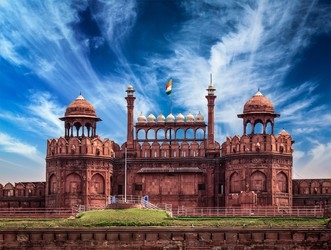
Red Fort At Delhi – History, Facts, Fees, Location, Timing
The Red Fort, also known as the “Lal Quila” in Hindi, is a historic fort located in Delhi, India. It was built by the Mughal emperor Shah Jahan between 1638 and 1648 and served as the main residence of the Mughal emperors. The fort is constructed of red sandstone and covers an area of about 254.67 acres. The fort’s walls extend up to 2 km and are surrounded by a moat. The fort comprises several palaces, halls, and mosques; the most notable is the Diwan-i-Khas, a hall of private audience, where the emperor would meet with dignitaries and hear petitions.
The fort also houses the Moti Masjid, a small mosque made of white marble, and the Hayat Bakhsh Bagh, a pleasure garden. The main entrance to the fort is the Lahori Gate, through which visitors can enter and see the Chatta Chowk, a covered bazaar. The fort also has the Diwan-i-Am, the Hall of Public Audience, and the Rang Mahal, the palace of colors famous for its intricate inlay work and frescoes. The fort is also a UNESCO World Heritage Site and one of Delhi’s most popular tourist attractions.
It is also the site of the annual Independence Day celebration, during which the Prime Minister of India hoists the national flag and delivers a speech to the nation. The Red Fort is a famous tourist spot and holds great historical and cultural significance, as it has witnessed several events that shaped India’s history. The Red Fort is one of the iconic monuments of India, and it is a symbol of the country’s rich culture and history.
Table of Contents
History of Red Fort
Shah Jahan, known for his love of architecture, decided to build the Red Fort as his new imperial palace after he shifted his capital from Agra to Delhi. He wanted to create a new, grand palace that would reflect the might and splendor of the Mughal empire. Ustad Ahmad Lahauri, a renowned architect of the time, supervised the fort’s construction. The fort was built over ten years and was finally completed in 1648.
Once completed, the Red Fort became the center of Mughal power and politics. The emperors would hold court and meet with dignitaries and officials in the Diwan-i-Khas, a hall of private audiences. At the same time, the Diwan-i-Am, the Hall of Public Audience, was used to hear petitions from commoners. The fort also housed several palaces, such as the Rang Mahal, the palace of colors famous for its intricate inlay work and frescoes.
It served as the main residence of the Mughal emperors until 1857 when the British East India Company took control of Delhi after the Indian Rebellion of 1857. The fort was subsequently used as a military barracks and a prison, and many of its buildings were damaged or destroyed. In 1903, the British government declared the Red Fort a protected monument and began restoration work.
After India gained independence in 1947, the Red Fort became a symbol of the country’s freedom and sovereignty.
Where does the name come from?
The fort’s walls are red sandstone, which is why it is called the Red Fort.
It is also said that the fort’s walls and buildings were whitewashed, but over time, they acquired a red hue due to exposure to the elements, which added to the origin of the name.
Different names also knew the fort through the years. It was referred to as Qila-i-Mubarak (the blessed fort) by Mughal Emperors and Lahori Gate because the fort’s main entrance faces the city of Lahore (Now in Pakistan).
Facts of the Red Fort
- The main entrance to the fort is the Lahori Gate, through which visitors can enter and see the Chatta Chowk, a covered bazaar.
- The fort is a UNESCO World Heritage Site.
- It is one of the most popular tourist attractions in Delhi.
- The Red Fort was the site of the annual Independence Day celebration, where the Prime Minister of India hoists the national flag and delivers a speech to the nation.
- After the Indian Rebellion of 1857, the British East India Company took control of Delhi and used the Red Fort as a military barracks and prison.
- The British government declared the Red Fort a protected monument in 1903 and began restoration work.
- It holds great historical and cultural significance as it has witnessed several events that shaped India’s history.
- The Red Fort’s architecture is a combination of Indian and Persian styles.
- The fort has several courtyards, including the Naqqar Khana courtyard, where the royal band used to perform.
- One of the most famous attractions within the Red Fort is the sound and light show, which tells the story of the fort and the Mughal era.
- The Red Fort complex includes the Khas Mahal, the emperor’s private palace, and the Mumtaz Mahal, the empress’s palace.
- The fort has intricate carvings and inlay work, particularly in the marble walls and ceilings of the palace buildings.
- The Red Fort is also home to the Hammam (royal bath) and the Royal Canal, used by the emperors and their households.
- During the Mughal period, It was surrounded by a large market known as the Urdu Bazaar, a popular shopping destination for the royal court and citizens.
- The Red Fort was also an important center for the arts and was home to several renowned musicians, poets, and artists of the Mughal era.
- It has undergone several renovations and restoration works since independence, and efforts are ongoing to preserve and restore the monument to its former glory.
- It’s also a popular spot for photography among visitors and locals. The fort is illuminated in the evening, making it look very captivating.
Fees for Red Fort
The fees for visiting the Red Fort vary based on several factors, including the type of ticket and the visitor’s age and nationality.
For Indian citizens, the ticket price for adults is INR 35, and for students, it is INR 15, while children under 15 years of age can enter the fort free of charge. For foreign nationals, the ticket price for adults is INR 600, and for students, it is INR 300.
There is also a separate ticket for the sound and light show that takes place in the evening. The sound and light show fee is INR 40 for Indian citizens and INR 540 for foreign nationals. There is also a separate fee for photography and videography, which is INR 25 for still photography and INR 200 for videography.
The Red Fort ticket is valid for a single entry and a single day only. A separate entry ticket is required if you want to visit the monument on different days and at times.
It’s important to note that these fees and prices are subject to change, so it’s always a good idea to check with the official website or the ticket office before visiting the Red Fort. Additionally, on certain days of the year, like national holidays, the Red Fort may be closed or have different timings, so check the schedule in advance is recommended.
Visitors can also hire guides, which will give them more information and context about the history and architecture of the Red Fort.
Location of the Red fort
Specifically, it is situated in the Old City of Delhi, on the eastern bank of the Yamuna River. The nearest major landmarks to the Red Fort are the Jama Masjid and the Chandni Chowk market.
It is also located in central Delhi and is well connected by public transport like the metro and bus. The nearest metro station to the Red Fort is the “Chandni Chowk” metro station which is located near the fort.
The address of the Red Fort is:
Netaji Subhash Marg, Lal Qila, Chandni Chowk, New Delhi, Delhi 110006, India
Timings for the Red Fort
The fort is open to visitors every day except for Monday.
The visiting hours:
Summer timings (April – September): 9:30 AM to 4:30 PM
Winter timings (October – March): 9:30 AM to 4:00 PM
It’s advisable to check the official website or call the authorities before planning a visit, as there could be some changes due to the ongoing pandemic.
Conclusion
You may visit the Red Fort in Delhi to look at the beautiful architecture and understand the culture of India. It holds a lot of significance for the citizens and is a great spot to visit for tourists. You should definitely visit it if you get a chance to do so!

Leave a Reply
You must be logged in to post a comment.